Drought Assessment in Zacatecas, Mexico
Abstract
:1. Introduction
2. Materials and Methods
2.1. Location of Study
2.2. SPI and RDI Approaches
2.3. Drought Severity Assessment
2.4. Software for Data Analysis and Drought Mapping
3. Results and Discussion
4. Conclusions
Acknowledgments
Author Contributions
Conflicts of Interest
Appendix A
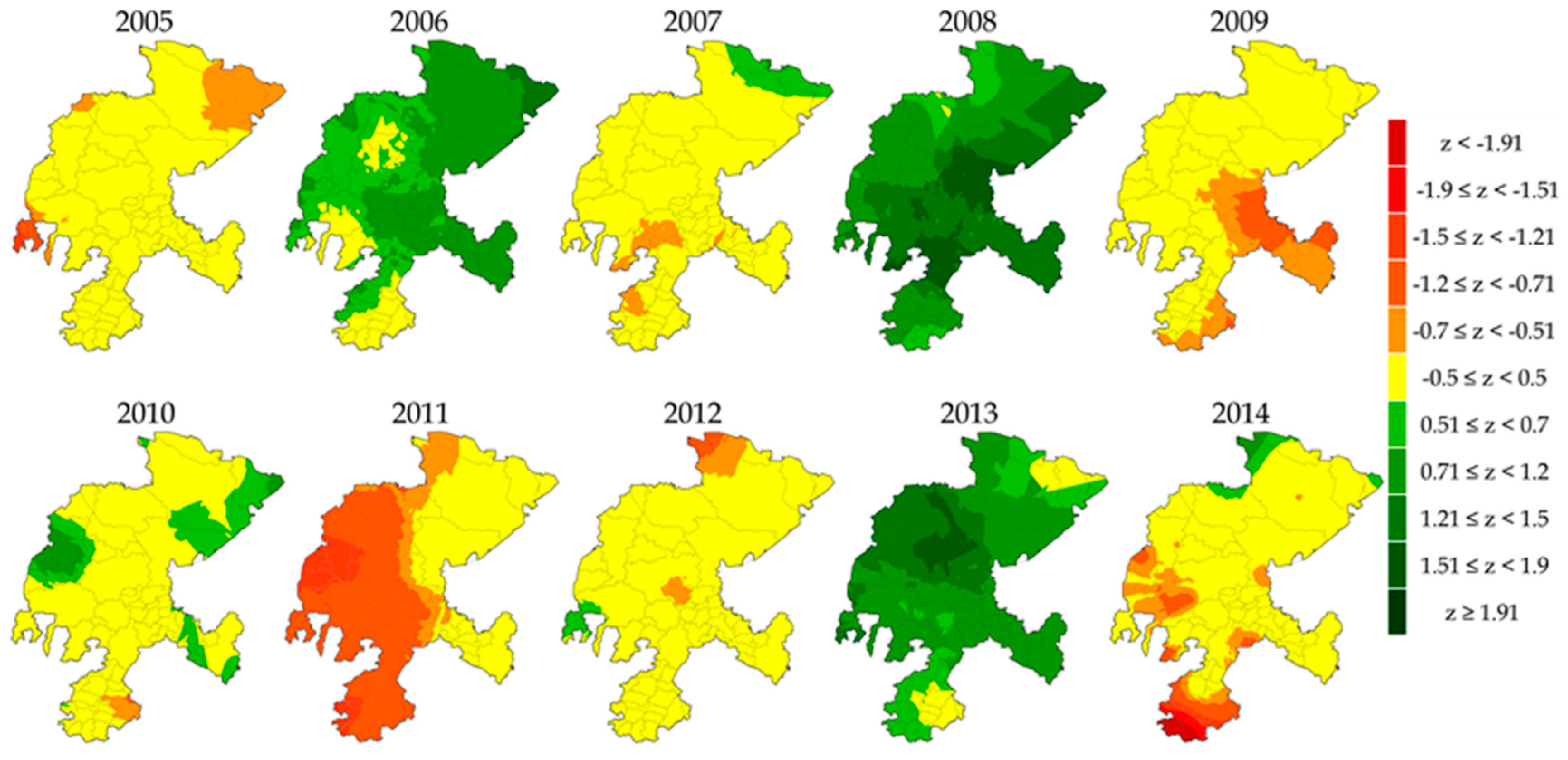
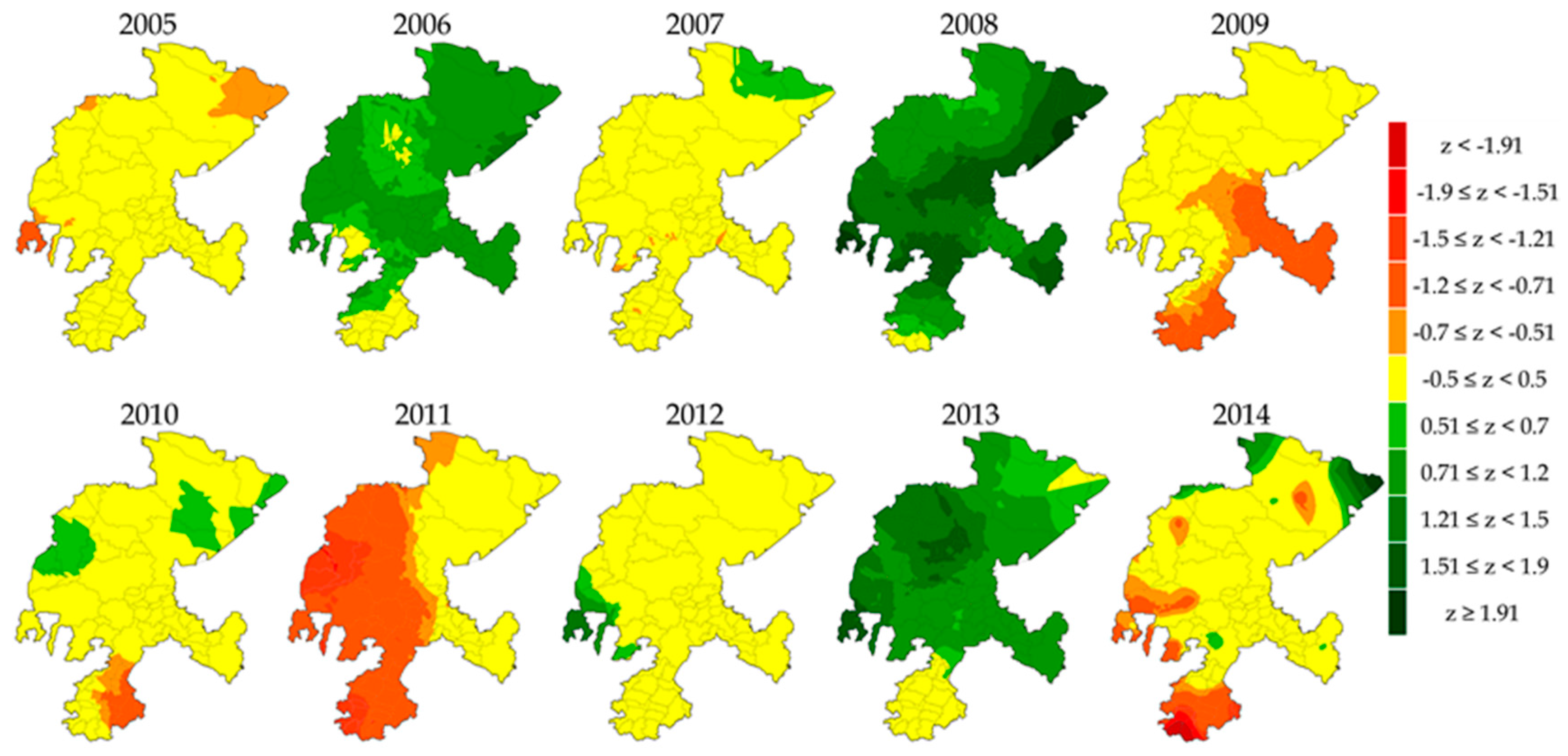

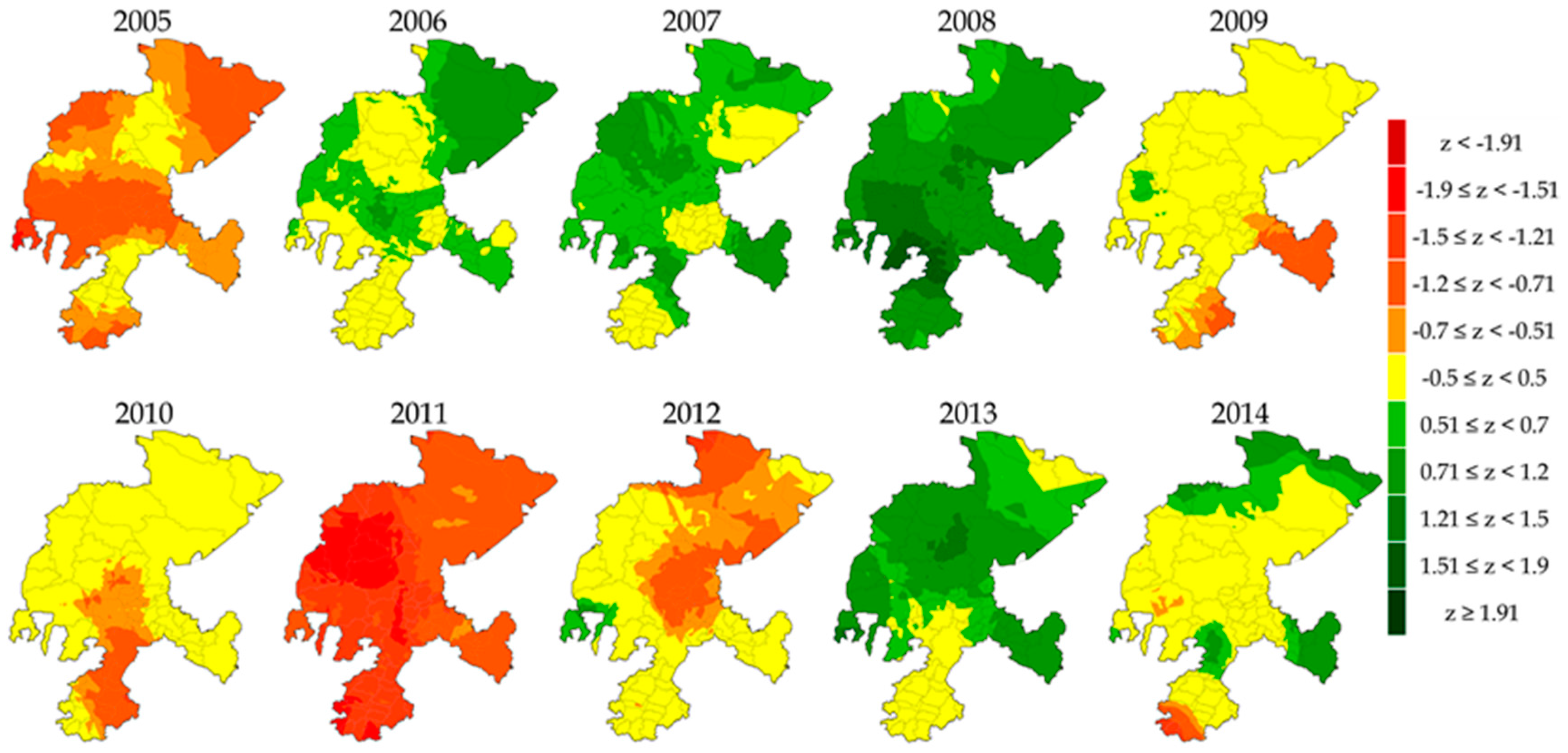
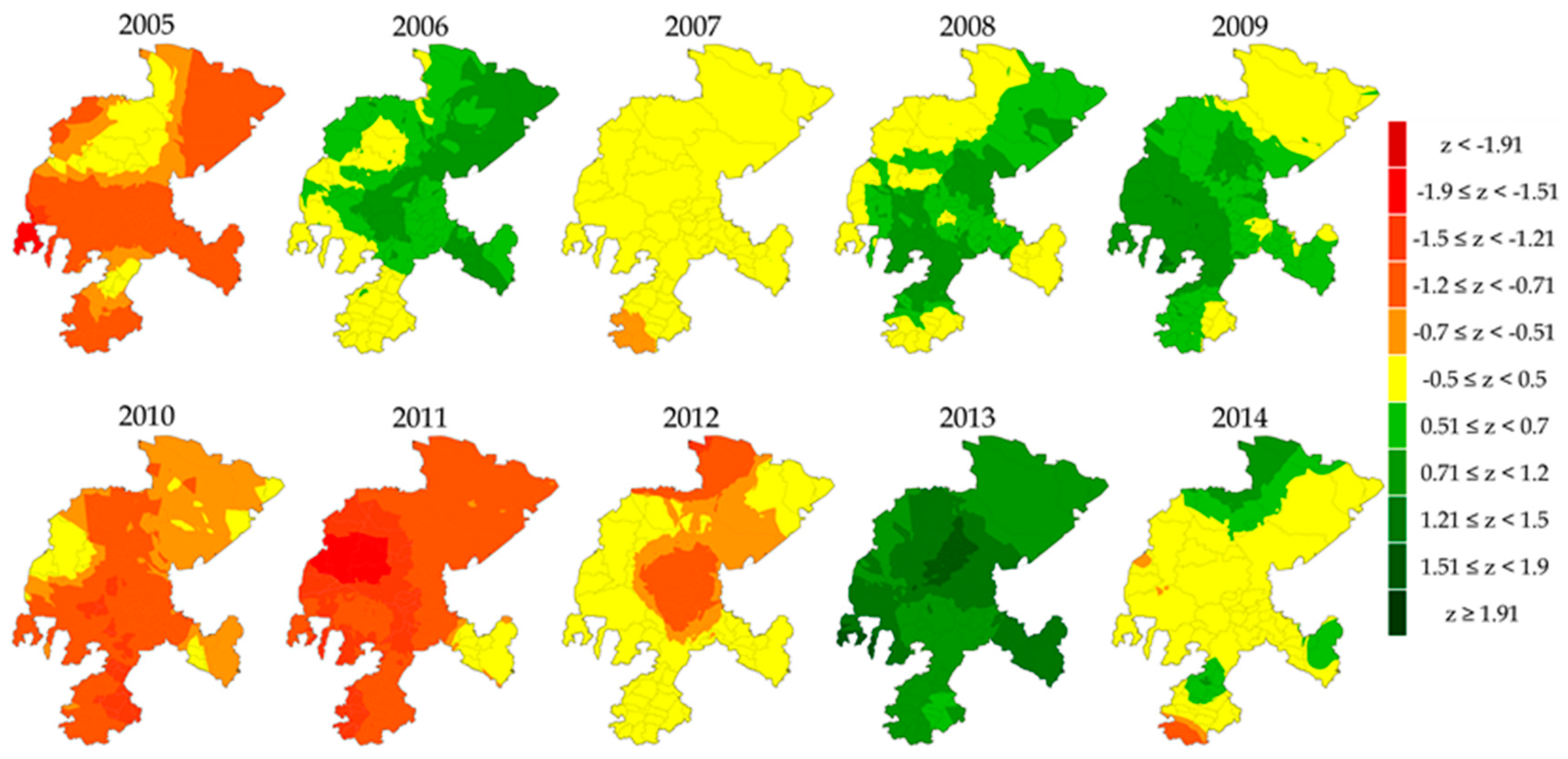
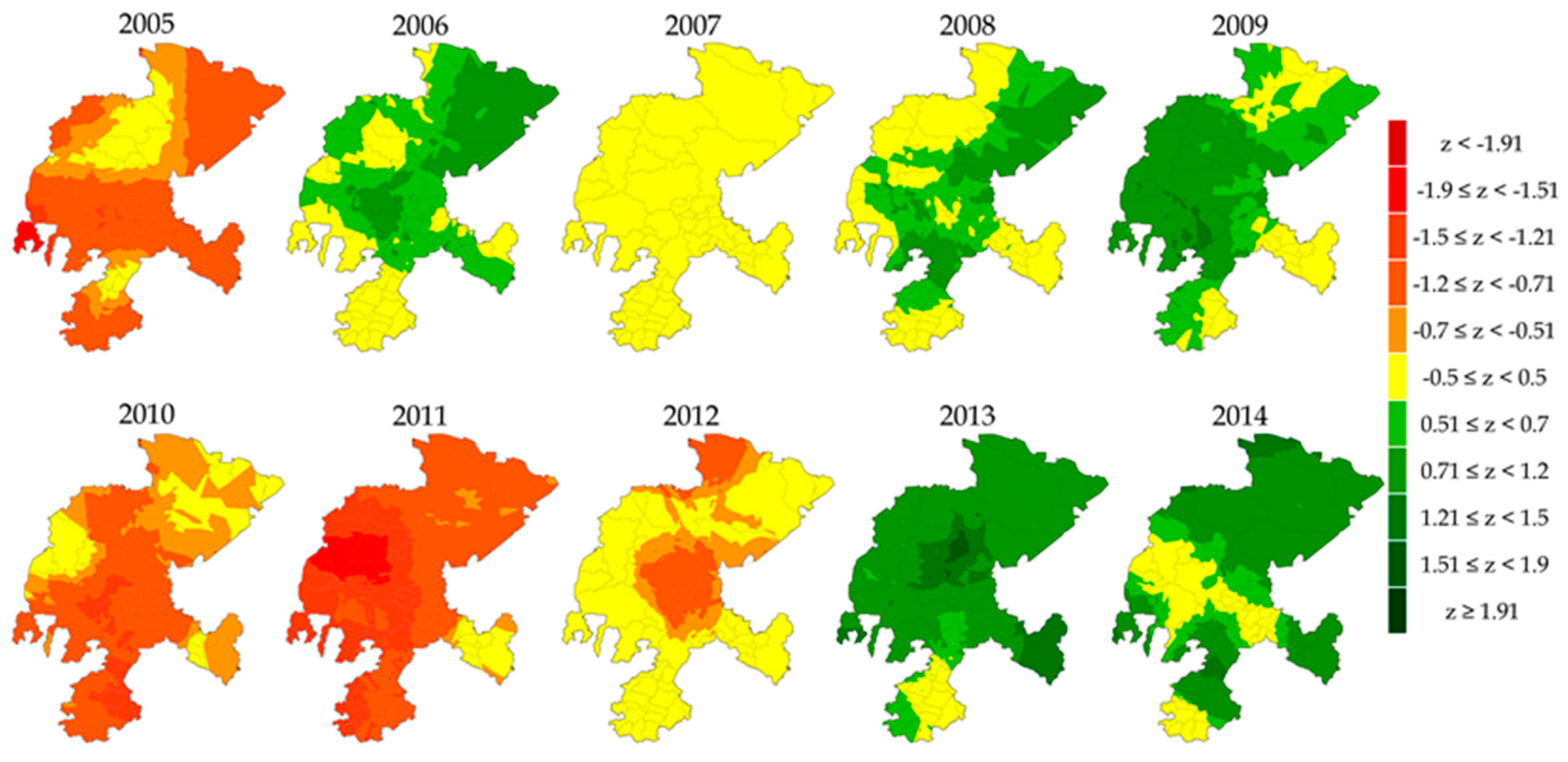
References
- Coumou, D.; Rahmstorf, S. A decade of weather extremes. Nat. Clim. Chang. 2012, 2, 491–496. [Google Scholar] [CrossRef]
- Perevochtchikova, M.; De La Torre, J.L.L. Causas de un desastre: Inundaciones del 2007 en Tabasco, México. J. Lat. Am. Geogr. 2010, 9, 73–98. [Google Scholar] [CrossRef]
- Rosenzweig, C.; Iglesias, A.; Yang, X.B.; Epstein, P.R.; Chivian, E. Climate change and extreme weather events; implications for food production, plant diseases, and pests. Glob. Chang. Hum. Health 2001, 2, 90–104. [Google Scholar] [CrossRef]
- Flores, L.I.; Bautista-Capetillo, C. Green and blue water footprint accounting for dry beans (Phaseolus vulgaris) in primary region of Mexico. Sustainability 2015, 7, 3001–3016. [Google Scholar]
- Boubacar, I. The effects of drought on crop yields and yield variability: An economic assessment. Int. J. Econ. Financ. 2012, 4, 51. [Google Scholar] [CrossRef]
- Padilla, G.; Rodríguez, L.; Castorena, G.; Florescano, E. Análisis Histórico de las Sequías en México; Secretaría de Agricultura y Recursos Hidráulicos, Comisión del Plan Nacional Hidráulico SARH: México D.F., Mexico, 1980. [Google Scholar]
- Corvera, M.C. Caracterización de la sequía en el estado de Zacatecas. Master’s Thesis, Universidad Autónoma de Zacatecas, Zacatecas, Mexico, 2007. [Google Scholar]
- Ortega-Gaucin, D.; Velasco, I. Aspectos socioeconómicos y ambientales de las sequías en México. Aqua-LAC 2013, 5, 78–90. [Google Scholar]
- Centro Nacional de Prevención de Desastres (CENAPRED). Reseña Histórica de Sequías en México y Otras Partes del Mundo; Secretaría de Gobernación, Government of Mexico: México D.F., Mexico, 2002.
- National Drought Mitigation Center (NDMC), University of Nebraska, Lincon, NE, USA. Available online: http://drought.unl.edu (accessed on 8 February 2016).
- Tsakiris, G.; Nalbantis, I.; Vangelis, H.; Verbeiren, B.; Huysmans, M.; Tychon, B.; Poelmans, L. A system-based paradigm of drought analysis for operational management. Water Resour. Manag. 2013, 27, 5281–5297. [Google Scholar] [CrossRef]
- Wilhite, D.A. Breaking the hydro-illogical cycle: Progress or status quo for drought management in the United States. Eur. Water 2011, 34, 5–18. [Google Scholar]
- Velasco, I. Plan de Preparación para Afrontar Sequías en un Distrito de Riego. Ph.D. Thesis, Divisón de Estudios de Posgrado de la Facultad de Ingeniería, Campus Morelos, The National Autonomous University of Mexico (UNAM), Cuernavaca, Mexico, 2002. [Google Scholar]
- Buttafuoco, G.; Caloiero, T. Drought events at different timescales in southern Italy (Calabria). J. Maps 2014, 10, 529–537. [Google Scholar] [CrossRef]
- Kousari, M.R.; Dastorani, M.T.; Niazi, Y.; Soheili, E.; Hayatzadeh, M.; Chezgi, J. Trend detection of drought in arid and semi-arid regions of Iran based on implementation of reconnaissance drought index (RDI) and application of non-parametrical statistical method. Water Resour. Manag. 2014, 28, 1857–1872. [Google Scholar] [CrossRef]
- Trambauer, P.; Maskey, S.; Werner, M.; Pappenberger, F.; Van Beek, L.P.H.; Uhlenbrook, S. Identification and simulation of space-time variability of past hydrological drought events in the Limpopo River basin, southern Africa. Hydrol. Earth Syst. Sci. 2014, 18, 2925–2942. [Google Scholar] [CrossRef]
- Mishra, A.K.; Singh, V.P. A review of drought concepts. J. Hydrol. 2010, 391, 202–216. [Google Scholar] [CrossRef]
- Vicente-Serrano, S.M.; Cuadrat-Prats, J.M.; Romo, A. Early prediction of crop production using drought indices at different time-scales and remote sensing data: Application in the Ebro Valley (North-East Spain). Int. J. Remote Sens. 2006, 27, 511–518. [Google Scholar] [CrossRef]
- Tsakiris, G.; Vangelis, H. Establishing a drought index incorporating evapotranspiration. Eur. Water 2005, 9, 3–11. [Google Scholar]
- Elagib, N.A. Meteorological drought and crop yield in sub-Saharan Sudan I. Int. J. Water Resour. Arid Environ. 2013, 2, 164–171. [Google Scholar]
- Tsakiris, G.; Vangelis, H.; Tigkas, D. Drought impacts on yield potential in rainfed agriculture. In Economics of Drought and Drought Preparedness in a Climate Change Context; López-Francos, A., Ed.; CIHEAM/FAO/ICARDA/GDAR/CEIGRAM/MARM: Zaragoza, Spain, 2010; Volume 95, pp. 191–197. [Google Scholar]
- Spinoni, J.; Naumann, G.; Vogt, J.V.; Barbosa, P. The biggest drought events in Europe from 1950 to 2012. J. Hydrol. Reg. Stud. 2015, 3, 509–524. [Google Scholar] [CrossRef]
- Naumann, G.; Spinoni, J.; Vogt, J.V.; Barbosa, P. Assessment of drought damages and their uncertainties in Europe. Environ. Res. Lett. 2015, 10, 1–14. [Google Scholar] [CrossRef]
- Jayasree, V.; Venkatesh, B. Analysis of rainfall in assessing the drought in semi-arid region of Karnataka State, India. Water Resour. Manag. 2015, 29, 5613–5630. [Google Scholar] [CrossRef]
- Historical Database of Precipitation and Temperature; Comisión Nacional del Agua (CONAGUA), Government of Mexico: México D.F., Mexico, 2015.
- Instituto Nacional de Estadística y Geoegrafía (INEGI). Información del Territorio Nacional por Entidad. Government of Mexico. Available online: http://cuentame.inegi.org.mx/monografias/informacion/zac/ (accessed on 4 July 2016).
- Martínez, D. Impacto de las Sequías en el Estado de Sinaloa dentro de la Actividad Agrícola y Ganadera. Master’s Thesis, Divisón de Estudios de Posgrado de la Facultad de Ingeniería, The National Autonomous University of Mexico (UNAM), México D.F., Mexico, 2006. [Google Scholar]
- Crespo, P.G. Comparación de dos Metodologías para el Cálculo de la Severidad de Sequía para Doce Reservas de la Biósfera Mexicana; UNESCO: Texcoco, Mexico, 2005. [Google Scholar]
- Zarch, M.A.A.; Sivakumar, B.; Sharma, A. Droughts in a warming climate: A global assessment of Standardized Precipitation Index (SPI) and Reconnaissance Drought Index (RDI). J. Hydrol. 2015, 526, 183–195. [Google Scholar] [CrossRef]
- McKee, T.B.; Doeskin, N.J.; Kleist, J. The relationship of drought frequency and duration to time scales. In Proceedings of the 8th Conference on Applied Climatology, Anaheim, CA, USA, 17–22 January 1993; pp. 179–184.
- Campos-Aranda, D.F. Comparación de tres métodos estadísticos para detección y monitoreo de Sequías meteorológicas. Agrociencia 2014, 48, 463–476. [Google Scholar]
- Thom, H.C.S. Same Methods of Climatological Analyses; World Meteorological Organization: Geneva, Switzerland, 1966. [Google Scholar]
- Abramowitz, M.; Stegun, I. Handbook of Mathematical Functions with Formulas, Graphs, and Mathematical Tables; Dover Publications Inc.: New York, NY, USA, 1970. [Google Scholar]
- Tigkas, D.; Vangelis, H.; Tsakiris, G. The RDI as a composite climatic index. Eur. Water 2013, 41, 17–22. [Google Scholar]
- Tsakiris, G.; Nalbantis, I.; Pangalou, D.; Tigkas, D.; Vangelis, H. Drought meteorological monitoring network design for the reconnaissance drought index (RDI). In Drought Management: Scientific and Technological Innovations; López-Francos, A., Ed.; Centre International de Hautes Etudes Agronomiques Méditerranéennes (CIHEAM): Zaragoza, Spain, 2008; Volume 80, pp. 57–62. [Google Scholar]
- Mosaedi, A.; Zare Abyaneh, H.; Ghabaei Sough, M.; Samadi, S.Z. Quantifying changes in reconnaissance drought index using equiprobability transformation function. Water Resour. Manag. 2015, 29, 2451–2469. [Google Scholar] [CrossRef]
- Vangelis, H.; Tigkas, D.; Tsakiris, G. The effect of PET method on Reconnaissance Drought Index (RDI) calculation. J. Arid Environ. 2013, 88, 130–140. [Google Scholar] [CrossRef]
- Zarch, M.A.A.; Malekinezhad, H.; Mobin, M.H.; Dastorani, M.T.; Kousari, M.R. Drought monitoring by reconnaissance drought index (RDI) in Iran. Water Resour. Manag. 2011, 25, 3485–3504. [Google Scholar] [CrossRef]
- Svoboda, M.; LeComte, D.; Hayes, M.; Heim, R.; Gleason, K.; Angel, J.; Rippey, B.; Tinker, R.; Palecki, M.; Stooksbury, D.; et al. The drought monitor. Bull. Am. Meteorol. Soc. 2002, 83, 1181–1190. [Google Scholar]
- Íñiguez, M.; Ojeda, W.; Díaz, C.; Mamadou Bâ, K.; Mercado, R. Análisis metodológico de la distribución espacial de la precipitación y la estimación media diaria. Rev. Mex. Cienc. Agríc. 2011, 2, 57–69. [Google Scholar]
- Viera, M.A.D. Geoestadística Aplicada; Instituto de Geofísica, Universidad Nacional Autónoma de México, Ministerio de Ciencia, Tecnología y Medio Ambiente de Cuba: México D.F., Mexico, 2002; pp. 31–57. [Google Scholar]
- ArcGIS PRO. Available online: https://pro.arcgis.com/en/pro-app/tool-reference/3d-analyst/ (accessed on 16 August 2016).
- Bohling, G. Kriging. Kansas Geological Survey, Technical Report. 2005. Available online: http://people.ku.edu/~gbohling/cpe940 (accessed on 16 August 2016).
- Oliver, M.A.; Webster, R. Kriging: A method of interpolation for geographical information systems. Int. J. Geogr. Inf. Syst. 1990, 4, 313–332. [Google Scholar] [CrossRef]
- Pedro-Monzonís, M.; Solera, A.; Ferrer, J.; Estrela, T.; Paredes-Arquiola, J. A review of water scarcity and drought indexes in water resources planning and management. J. Hydrol. 2015, 527, 482–493. [Google Scholar] [CrossRef]
- Hurtado, G.M. Cadena, Aplicación de índices de sequía en Colombia. Meteorol. Colomb. 2002, 5, 131–137. [Google Scholar]
- Luna, M. Antología Cultivos Básicos en Zacatecas; Universidad Autónoma de Zacatecas: Zacatecas, Mexico, 2014; Available online: https://www.academia.edu/11532162/ (accessed on 16 August 2016).
- Medina, G.; Rumayor, R.; Cabañas, C.; Luna, F.; Ruiz, C.; Gallegos, V.; Madero, J.; Gutiérrez, R.; Rubio, S.; Bravo, L. Potencial Productivo de Especies Agrícolas en el Estado de Zacatecas; Instituto Nacional de Investigaciones Forestales, Agrícolas y Pecuarias, Centro de Investigación Regional Norte Centro: Calera, Zacatecas, Mexico, 2003. [Google Scholar]
- Comisión Nacional del Agua (CONAGUA). Política Pública Nacional para la Sequía; Programa Nacional contra la Sequía, Government of Mexico: México D.F., Mexico, 2014.
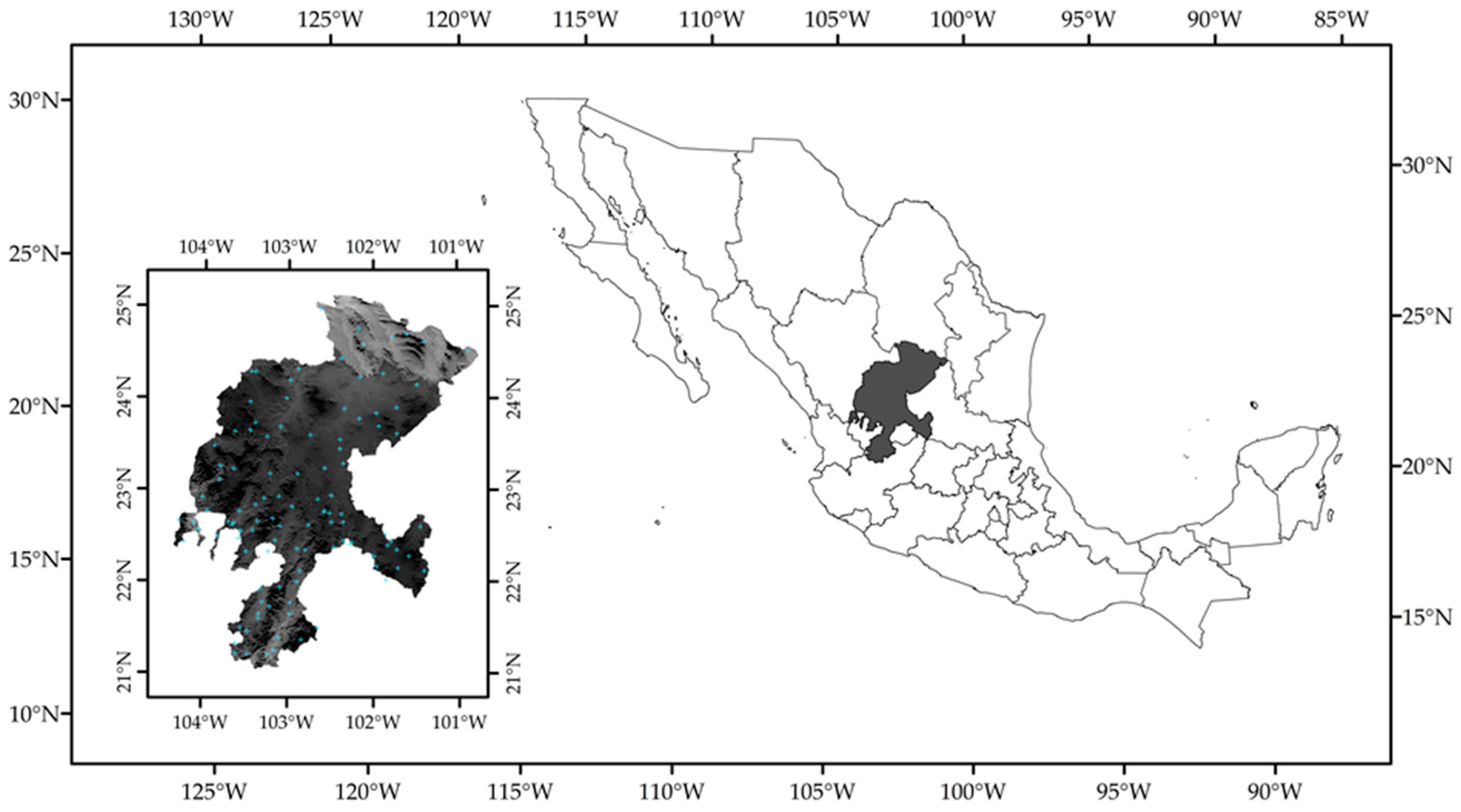

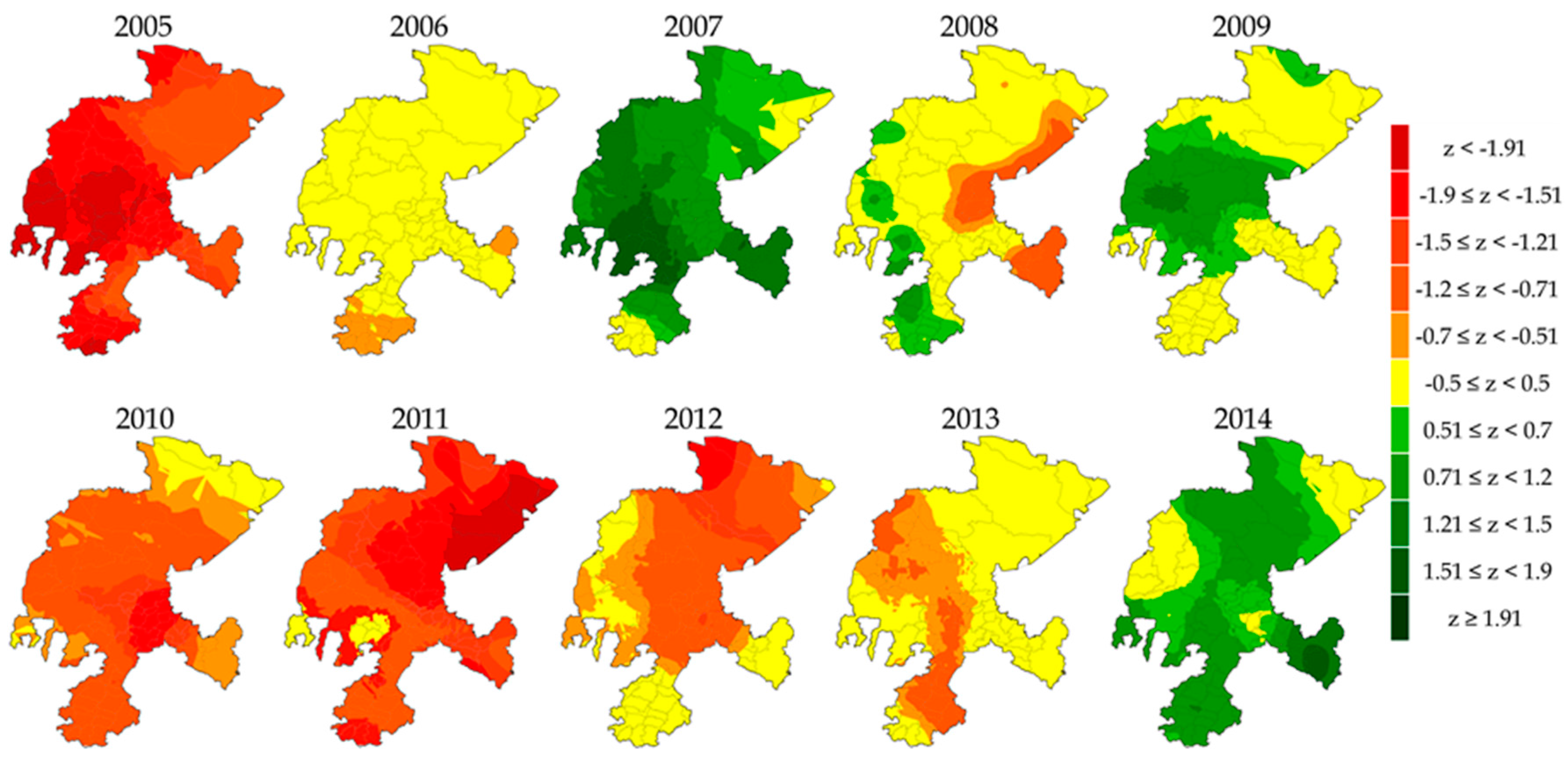
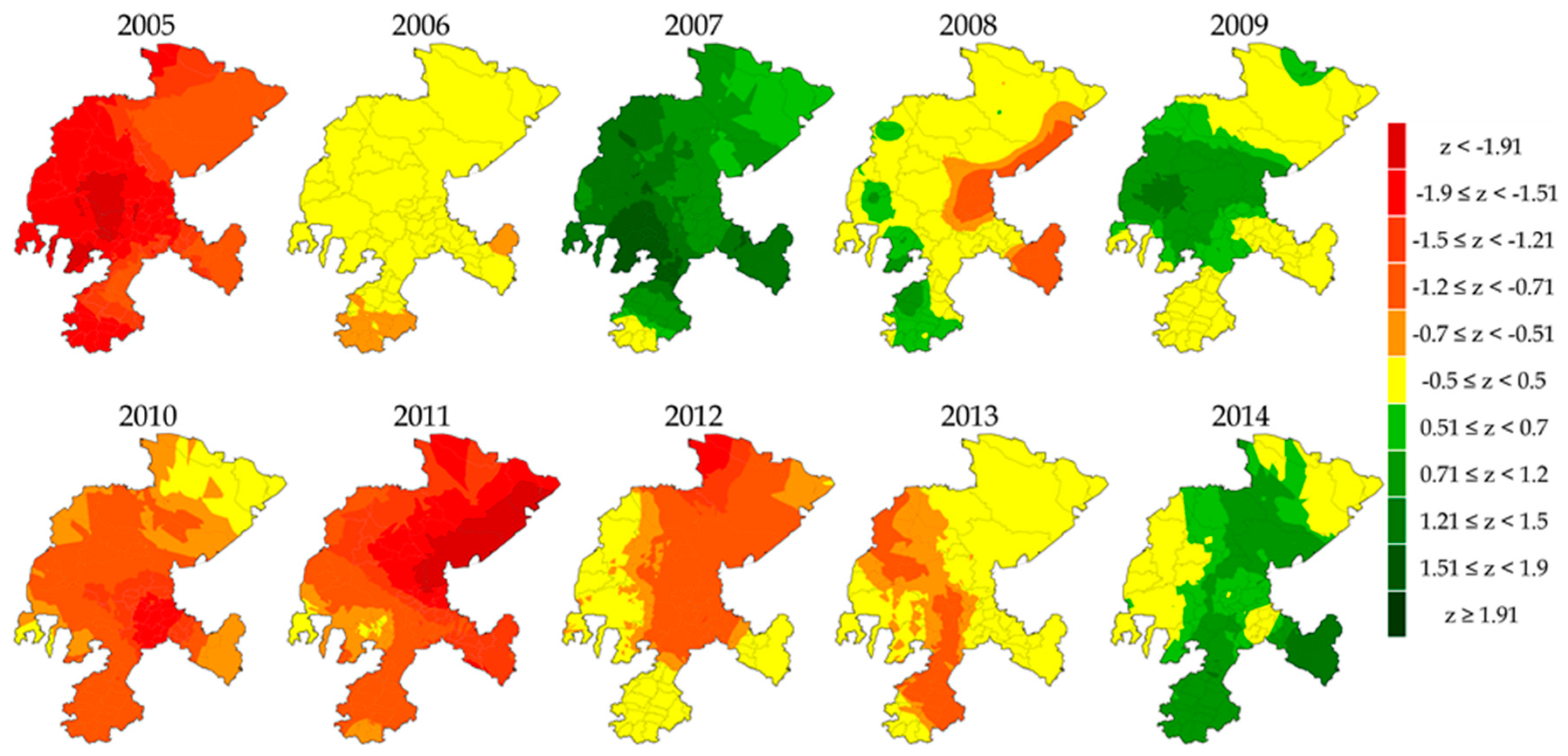
| Index Value | Condition |
|---|---|
| Z < −1.91 | Exceptional drought |
| −1.90 < Z ≤ −1.51 | Extreme drought |
| −1.50 < Z ≤ −1.21 | Severe drought |
| −1.20 < Z ≤ −0.71 | Moderate drought |
| −0.70 < Z ≤ −0.51 | Incipient drought |
| −0.50 < Z ≤ 0.51 | Normal conditions |
| 0.51 < Z ≤ 0.70 | Incipient wet |
| 0.71 < Z ≤ 1.20 | Moderate wet |
| 1.21 < Z ≤ 1.50 | Very wet |
| 1.51 < Z ≤ 1.90 | Extreme wet |
| 1.91 < Z | Exceptional wet |
| Year | Index | Timescale (Months) | Period | Exceptional Drought | Extreme Drought | Severe Drought | Moderate Drought | Incipient Drought | Normal Conditions | Incipient Wet | Moderate Wet | Very Wet | Extreme Wet | Exceptional Wet |
|---|---|---|---|---|---|---|---|---|---|---|---|---|---|---|
| 2005 | SPI | 3 | April–June | 21 | 34 | 19 | 27 | |||||||
| July–September | 11 | 87 | ||||||||||||
| RDI | April–June | 8 | 40 | 19 | 32 | |||||||||
| July–September | 8 | 91 | ||||||||||||
| SPI | 6 | April–September | 51 | 35 | 12 | |||||||||
| RDI | 44 | 35 | 20 | |||||||||||
| SPI | 12 | April–March | 60 | 19 | 18 | |||||||||
| RDI | 61 | 20 | 15 | |||||||||||
| 2007 | SPI | 3 | April–June | 9 | 18 | 35 | 28 | 10 | ||||||
| July–September | 5 | 88 | 6 | |||||||||||
| RDI | April–June | 18 | 35 | 34 | 10 | |||||||||
| July–September | 92 | 7 | ||||||||||||
| SPI | 6 | April–September | 44 | 47 | 9 | |||||||||
| RDI | 24 | 49 | 26 | |||||||||||
| SPI | 12 | April–March | 97 | |||||||||||
| RDI | 100 | |||||||||||||
| 2011 | SPI | 3 | April–June | 12 | 23 | 25 | 27 | 9 | ||||||
| July–September | 8 | 43 | 11 | 39 | ||||||||||
| RDI | April–June | 14 | 21 | 26 | 28 | 8 | ||||||||
| July–September | 10 | 41 | 8 | 41 | ||||||||||
| SPI | 6 | April–September | 11 | 36 | 52 | |||||||||
| RDI | 16 | 36 | 46 | |||||||||||
| SPI | 12 | April–March | 8 | 25 | 60 | 6 | ||||||||
| RDI | 8 | 32 | 51 | 6 | ||||||||||
| 2014 | SPI | 3 | April–June | 20 | 24 | 49 | 5 | |||||||
| July–September | 5 | 10 | 77 | |||||||||||
| RDI | April–June | 35 | 24 | 35 | 6 | |||||||||
| July–September | 9 | 8 | 71 | |||||||||||
| SPI | 6 | April–September | 77 | 10 | 8 | |||||||||
| RDI | 66 | 16 | 14 | |||||||||||
| SPI | 12 | April–March | 74 | 16 | 7 | |||||||||
| RDI | 21 | 15 | 59 |
| Year | Sown | Harvested | Sinistered | Economic Losses (%) | |||
|---|---|---|---|---|---|---|---|
| Mha | M$ | Mha | M$ | Mha | M$ | ||
| 2005 | 1.05 | 98 | 0.55 | 52 | 0.50 | 46 | 47 |
| 2006 | 1.10 | 200 | 1.08 | 197 | 0.02 | 3 | 2 |
| 2007 | 1.11 | 145 | 0.90 | 117 | 0.21 | 28 | 19 |
| 2008 | 1.10 | 263 | 0.99 | 243 | 0.11 | 20 | 8 |
| 2009 | 1.10 | 359 | 0.65 | 219 | 0.42 | 140 | 39 |
| 2010 | 1.10 | 175 | 0.87 | 138 | 0.23 | 37 | 21 |
| 2011 | 0.93 | 197 | 0.35 | 74 | 0.58 | 123 | 63 |
| 2012 | 1.01 | 302 | 0.83 | 250 | 0.17 | 52 | 21 |
| 2013 | 1.10 | 289 | 1.08 | 286 | 0.02 | 3 | 1 |
| 2014 | 1.02 | 246 | 0.92 | 220 | 0.10 | 26 | 11 |
© 2016 by the authors; licensee MDPI, Basel, Switzerland. This article is an open access article distributed under the terms and conditions of the Creative Commons Attribution (CC-BY) license (http://creativecommons.org/licenses/by/4.0/).
Share and Cite
Bautista-Capetillo, C.; Carrillo, B.; Picazo, G.; Júnez-Ferreira, H. Drought Assessment in Zacatecas, Mexico. Water 2016, 8, 416. https://doi.org/10.3390/w8100416
Bautista-Capetillo C, Carrillo B, Picazo G, Júnez-Ferreira H. Drought Assessment in Zacatecas, Mexico. Water. 2016; 8(10):416. https://doi.org/10.3390/w8100416
Chicago/Turabian StyleBautista-Capetillo, Carlos, Brenda Carrillo, Gonzalo Picazo, and Hugo Júnez-Ferreira. 2016. "Drought Assessment in Zacatecas, Mexico" Water 8, no. 10: 416. https://doi.org/10.3390/w8100416
APA StyleBautista-Capetillo, C., Carrillo, B., Picazo, G., & Júnez-Ferreira, H. (2016). Drought Assessment in Zacatecas, Mexico. Water, 8(10), 416. https://doi.org/10.3390/w8100416







